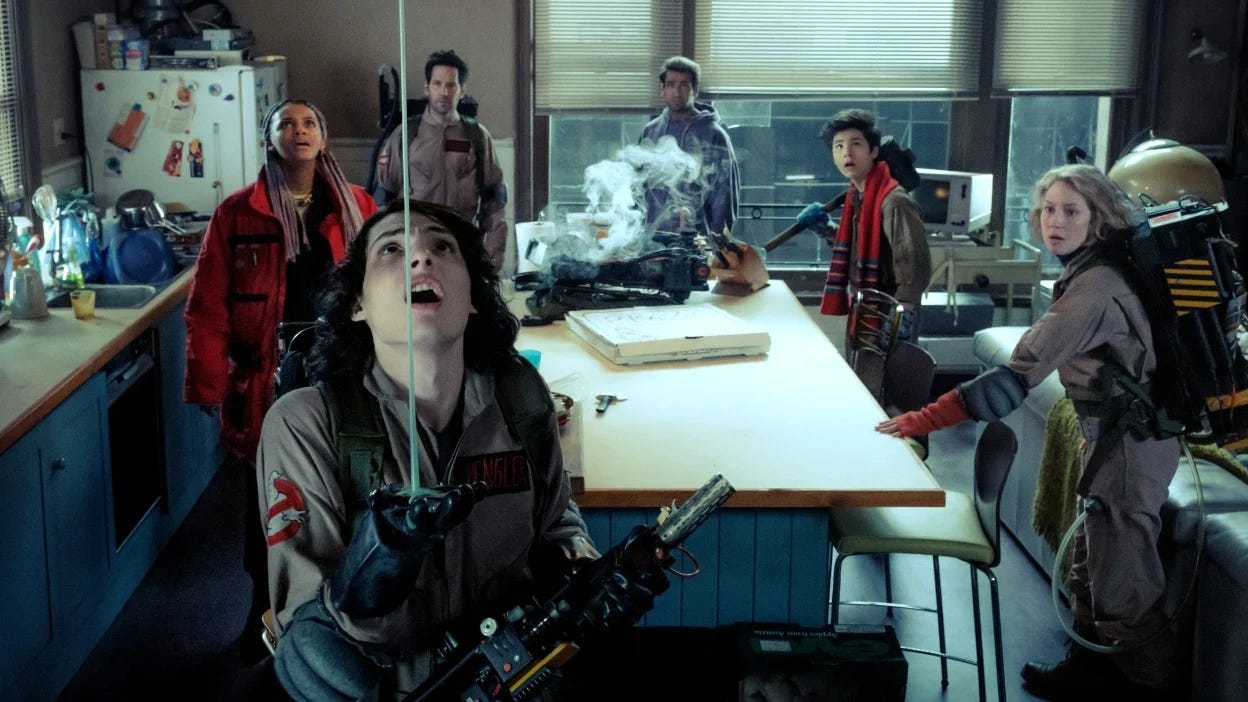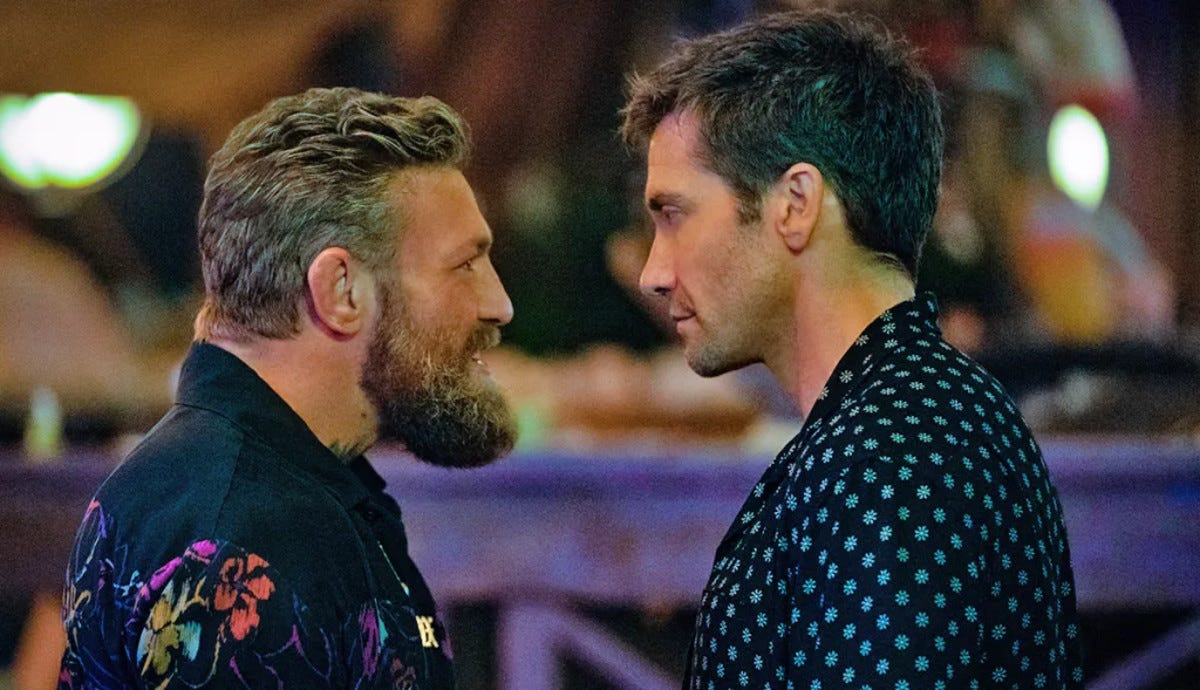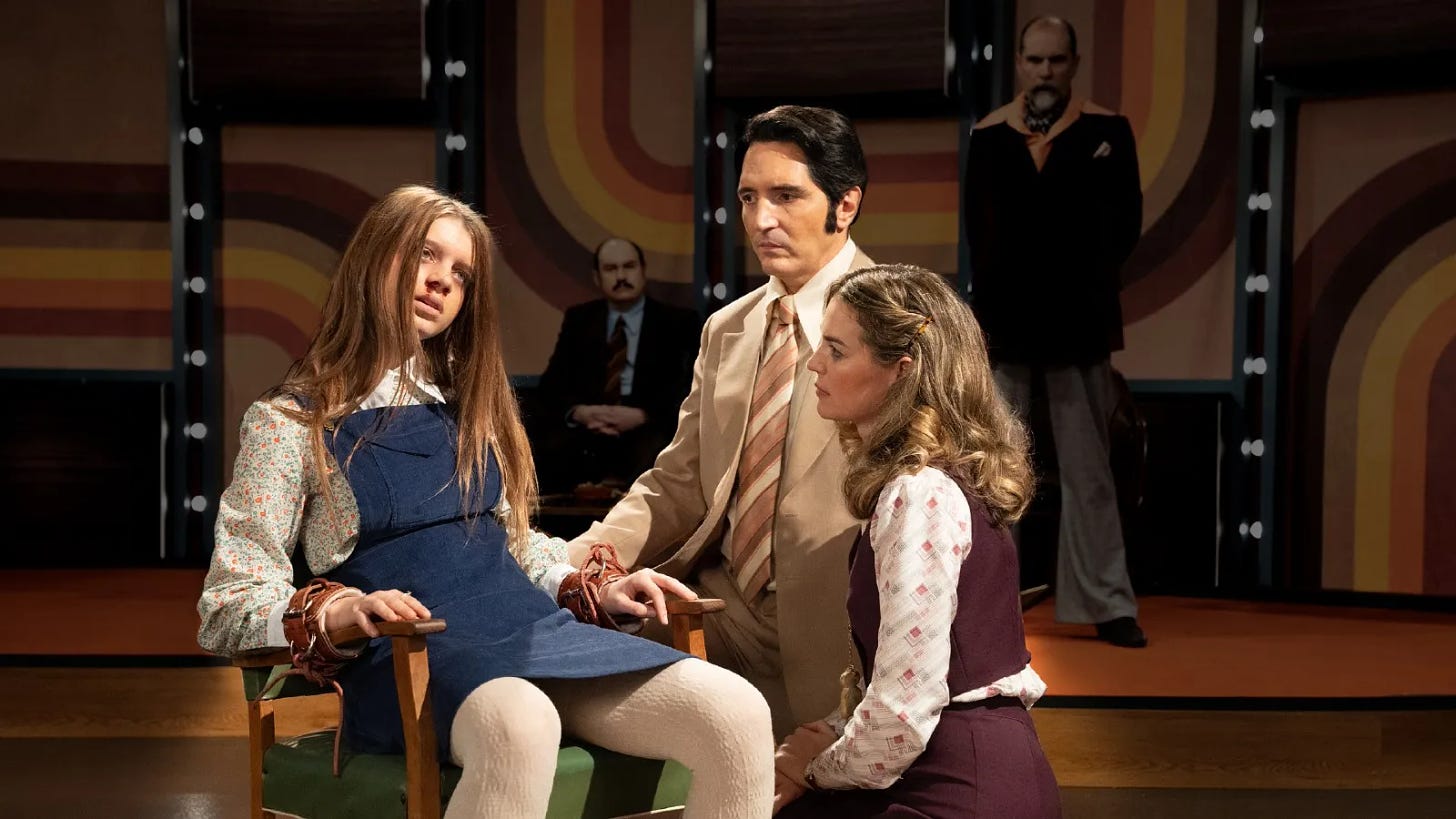In Review: 'Ghostbusters: Frozen Empire,' 'Road House,' 'Do Not Expect Too Much From the End of the World,' 'Late Night with the Devil'
After some slow weeks, it's a moviepalooza with new releases that feature everything from Ghostbusters to a cameo appearance by infamous German director Uwe Boll.
Ghostbusters: Frozen Empire
Dir. Gil Kenan
115 min.
There may be no better example of the ruinous influence of fan culture than the Ghostbusters franchise, which started 40 years ago as an amiable lark, then somehow shifted into the realm of Star Wars-level mythos the moment women wanted to get involved. The question of whether Ivan Reitman’s blockbuster comedy could even work as a sequel had already been answered with an emphatic “no” by 1989’s Ghostbusters II, which made a fortune on opening weekend before hemorrhaging viewers after people saw how terrible it was. For years, Bill Murray acted as a one-man containment unit for future sequels by refusing to appear in a second sequel, but the 2016 Ghostbusters was considered such an affront to a certain species of middle-aged man that Reitman’s son Jason swooped in to set things right.
And so now we have two sequels from the younger Reitman and Gil Kenan, who collaborated on the script (with Reitman directing) for 2021’s Ghostbusters: Afterlife and have done so again (with Kenan directing) on the new Ghostbusters: Frozen Empire. The underlying message of both seems to be: “Fellas, we read the Lady Ghostbusters message boards and you don’t have to worry anymore.” The Reitman/Kenan films have essentially paved over the 2016 Ghostbusters—there are about 12 people busting ghosts now, and none of them are played by Melissa McCarthy, Kirsten Wiig, Kate McKinnon, or Leslie Jones—but they’ve taken the task so gravely that Afterlife couldn’t even be called a comedy. Nostalgia had to be mined for all the original Ghostbusters equipment and gags and specters. Homage had to be paid to the late Harold Ramis, who turns up as a benevolent ghost. Bustin’ was too important to feel good anymore.
To extend some credit to this moribund series, Frozen Empire at least course-corrects enough to include some comedy this time around. Kumail Nanjiani has a good time as a layabout who tries to hawk his grandmother’s world-ending mystical orb for $60 in rent money. Patton Oswalt turns up as a librarian with an amusingly deep knowledge of supernatural arcana, briefly reminding audiences that there’s such a thing as infectious fan enthusiasm. Dan Aykroyd, always the most eager of the original Ghostbusters to keep the flame alive, at least seems to care about investing himself in all this mumbo-jumbo, which contrasts sharply with Bill Murray, who ambles around the set as if he’s looking for Accounts Payable. Though Murray’s bored deadpan was the comic engine of the original film, there’s a not-so-fine-line here between droll and completely checked out.
Returning the series to Manhattan after its peculiar detour in rural Oklahoma, Frozen Empire follows Callie Spengler (Carrie Coon), her kids Trevor (Finn Wolfhard) and Phoebe (Mckenna Grace), and summer-school-teacher-turned-side-piece Gary Grooberson (Paul Rudd) to the original Ghostbusters firehouse, where they set up shop again. There’s a lot of new business about Winston (Ernie Hudson) restoring the place and setting up a second research facility and containment unit just outside the city to handle the excess ghost storage. But the big threat this time is Nanjiani’s orb, which functions as a trap for a major supernatural baddie that can ice up the entire city in the middle of summer.
If the Ghostbusters simply left the orb alone, then everything would be fine, which is a terrific accidental metaphor for a franchise that should never have been revived. As Ghostbusters II made obvious, the sequels can’t get the same laughs from the absurd spectacle of academic outcasts saving New York with jumpsuits and proton packs, but they nonetheless go through the motions. Of the many bad ideas at play in Frozen Empire, including the return of an annoying hanger-on named “Podcast” and other friends who could have stayed in Oklahoma, the worst is saddling Phoebe, the one semi-amusing new character in Afterlife, with a same-sex-curious relationship with a like-aged ghost that plays it too coy to seem daring. It doesn’t seem like those 2016 Ghostbusters message boards would approve of that twist, either, so maybe Reitman and Kenan will feel compelled to reboot themselves. — Scott Tobias
Ghostbusters: Frozen Empire opens in theaters everywhere tonight.
Road House
Dir. Doug Liman
121 min.
It took a while for the cult following around Rowdy Herrington’s 1989 film Road House to fully bloom. Though successful at the box office, little about the way it was sold to the public set it apart from other late-’80s action films, apart from Dirty Dancing star Patrick Swayze and a fleeting glimpse of a monster truck in the trailer. Then, over the years, its weirdness became better known.“Pain don’t hurt” became a kind of B-movie koan and moments like a collapsing stuffed polar bear and Swayze’s man-of-few-word bouncer Dalton casually mentioning his philosophy degree from NYU helped the film find an appreciative audience. The film itself is something of a koan. It’s so stupid it’s smart but it’s also smart enough to know it’s stupid. It resists categorization. It’s just Road House.
Inevitably, any remake is destined to be, well, not Road House, because there can only be one. But, for a while at least, Doug Liman’s loose reinvention finds its own weird groove, in sync with Jake Gyllenhaal’s interpretation of Dalton as a kindly mannered, soft-spoken, low-energy muscleman who practically sighs in annoyance whenever he has to throw a punch. And he doesn’t have to throw many, at least at first. As the film opens, Dalton makes his money Jack Reachering from one scuzzy fight venue to the next, joining take-all-comers matches that end the moment his opponents recognize him. Dalton’s reputation precedes him. Even the toughest tough guy would rather bow out than take him on.
That reputation, we learn over the course of several flashbacks, stems from Dalton’s time as a UFC fighter, a career he’s fled with good reason. It’s clear Dalton wants no attachments, never mind settling down, but he nonetheless takes a gig that will keep him in one place when Frankie (Jessica Williams), owner of an embattled Florida Keys roadhouse called simply Road House, hires him to keep order in a venue where the music acts don’t even stop playing when the fists and bottles start flying. And, yes, Frankie knows “roadhouse” is one word and her place renders it as two. Her uncle had a strange sense of humor.
That winking exchange isn’t even the biggest lantern hung by the film, particularly when compared to the moment when Charlie (Hannah Love Lanier), a local kid who helps her dad run a nearby bookstore, suggests Dalton’s job “kinda sounds like the plot of a western.” And Charlie doesn’t even know that Dalton will soon be standing up to a wealthy, sneering villain named Brandt (Billy Magnussen) who commands a band of outlaws.
It’s all pretty fun until it stops being fun and turns into a pedestrian action movie distinguished mostly by Liman’s flashy camerawork. The turning point arrives pretty much when Knox (UFC fighter Conor McGregor), the film’s big bad, enters the picture. McGregor’s well cast as a repellent asshole, but he overplays the part and the film puts way too much faith in the notion that the camera can somehow transform his tough guy barking and default expression—a malevolent grin—into charisma. It can’t and though McGregor’s not the only element that weighs Road House down, he certainly doesn’t help. What starts well ends dully. It’s not smart-stupid or stupid-smart. And it’s definitely not Road House (1989). —Keith Phipps
Road House is currently streaming on Prime Video.
Do Not Expect Too Much From the End of the World
Dir. Radu Jude
163 min.
Some hyperbole that also happens to be true: The last two satires by Romanian director Radu Jude, Bad Luck Banging (or Loony Porn) and Do Not Expect Too Much From the End of the World have more to say about what it’s like to live right now than any film in the last three years. Emphasis on right now. If they were shot on celluloid, you’d say the print was still dripping from the lab, given how up-to-the-minute Jude’s essayistic observations turn out to be. It might take cinema years to catch up with the COVID pandemic and the brush fire it sparked in civil society, but Bad Luck Banging documented it on the spot, to the point where Jude’s Romania doubled as the most relevant film about America. His follow-up swiftly dissects the horrors of late capitalism, from the endless hustle of the gig economy to the scourge of social media influencers. It feels like he made it five minutes ago.
The secret with both films, beyond the liveliness of their structural gearshifts, is that Jude conceives a simple premise as a through-line for social commentary, like a stream breaking off into fascinating little tributaries and eddies. In Bad Luck Banging, it was a teacher brought before an inquisition of concerned parents and administrators after a private sex tape leaked to the internet. Here, another compromised young woman, Angela (Ilinca Manolache), drives through the hostile, traffic-choked streets of Bucharest to shoot crude auditions for a work safety video. Jude makes her a case study for an agitated, exploited generation of gig workers while the job itself takes her out into the wider world, where other observations about the city and culture come spilling out.
For her part, Angela isn’t shy about speaking her mind, especially when she turns her phone camera on herself. Using a filter that scrubs away her long blonde hair and gives her a thick unibrow, Angela records short videos as “Bobita,” a parody of social media star Andrew Tate, the outrageously vile misogynist who’s famously stationed in Romania. (In one clip, Bobita brags about double-teaming a truck-stop tramp with King Charles at the Queen’s funeral while learning how the palace lawn gets so pristine.) Jude follows Angela to various apartments where she interviews victims of work accidents, all of them in wheelchairs, about what happened to them on the job. The irony is that the safety advice they’re being asked to give for the corporate video has no bearing on their accidents. They’re just desperate people, hopeful to collect whatever fee they can get.
A couple of familiar faces pop up during Angela’s urban odyssey, most notably the great Nina Hoss as the Austrian CEO overseeing the project, who’s friendly enough to her during a ride from the airport to her luxury hotel, but is conspicuously out of touch with her host country. (When the two discuss the city’s traffic accidents, a result of government neglect and corruption, Hoss’ character suggests that “maybe robots or Tesla or other self-driving cars will solve this problem.”) Director Uwe Boll, the German schlockmeister responsible for Alone in the Dark and Postal, also gets an astonishing cameo where he talks to Angela about the time he beat up his critics in the ring. In a Radu Jude film, anything is possible.
With Do Not Expect Too Much, Jude make other strong choices, too, like cutting color footage from a 1981 film called Angela Moves On with the black-and-scenes of Manolache’s Angela in contemporary Bucharest, contrasting the cab driver of the former with Jude’s heroine, who does rideshare work when she’s not logging time as a production assistant. He also breaks off late into a second part that turns the focus on the man who’s ultimately chosen to shoot the work video. Along the way, there’s provocative chatter about figures from Ceaușescu to Anthony Bourdain to Jean-Luc Godard, and barbs aimed at Romanian racism and antisemitism as well as the systemic failures that haunt its citizens. It’s an endlessly surprising and rambunctious piece of work, nimble enough to pivot wherever Jude chooses to take it. Hang on for dear life. — Scott Tobias
Do Not Expect Too Much From the End of the World opens in limited release tomorrow.
Late Night With the Devil
Dir. Colin Cairnes, Cameron Cairnes
93 min.
Returning from a commercial, late night host Jack Delroy (David Dastmalchian) apologizes to the viewers watching the live broadcast of Night Owls for what they witnessed just before the break. His eyes radiate sincerity but his mouth can’t resist twisting, just for a half-second, into a satisfied smile. Since debuting a few years earlier, Night Owls has struggled to offer serious competition with Johnny Carson’s Tonight Show and now, on Halloween night, 1977, the show’s begun to approach a make-or-break point. But this episode? It’s the kind that could turn the show’s fortunes around, even if what they just broadcast has led the FCC to call an emergency meeting in the morning. Ethics be damned: Look at that share!
Written and directed by the Australian brother Colin and Cameron Cairnes, Late Night with the Devil finds a new twist on the found footage horror genre, taking the form (after a scene-setting documentary intro narrated by Michael Ironside) of a memorable “rediscovered” episode of Night Owls and behind-the-scenes footage of the mounting chaos surrounding its production. This being a Halloween episode, Jack and his staff have lined up a slate of guests that includes a colorful medium named Christou (Fayssal Bazzi), a magician turned debunker once named Carmichael the Conjurer (Ian Bliss), and Dr. June Ross-Mitchell (Laura Gordon), a parapsychologist accompanied by Lilly (Ingrid Torelli), the sole survivor of a suicidal satanic cult.
The question of whether not the experience has left Lilly possessed by an evil spirit becomes the subject of a fierce debate, with June making a reasonable-sounding case to keep an open mind, Carmichael remaining a dug-in skeptic, and Jack serving as the amiable, aw-shucks heartland-born host. And just as the Cairnes nail the trappings of a 1970s talk show, from the camera angles to the put-upon sidekick (Rhys Auteri), Dastmalchian has the act down, playing the everyman witness to the weirdness around him as Jack Paar, Johnny Carson, and (a bit later) David Letterman did. (Natives of, respectively, Ohio, Nebraska, and Indiana, it’s worth noting.)
But Jack’s not quite as much the outsider as his TV persona suggests, and as the episode proceeds, it starts to look like this night has been arranged for his benefit. Dastmalchian plays the fear and darkness beneath the friendly surface just as effectively as the good-humored host as what looks for a while like a triumphant night takes a turn. Late Night with the Devil might have played as a gimmick, but Dastmalchian’s intense performance and the Cairnes’ commitment to the bit (to say nothing of some truly grody effects in the film’s home stretch) give it an edge that gets increasingly unsettling the closer Night Owls gets to the end of what’s sure to be its most memorable episode. But who could possibly touch the dial and see what else is on as all hell (possibly literally) breaks loose? —Keith Phipps
Late Night with the Devil opens in select theaters tonight.













Your opening paragraph nails what I hate about the trailer for this new Ghostbusters. The portentous tone and music is so, so *off.*. You wanna know what the tone of the Ghostbusters (1984) movie is? Listen to the original song. That's the tone.
Imagine an Animal House remake where the trailer features the Kronos Quartet playing the Winter Overture from Requiem for a Dream as the VO intones "Fat, drunk, and stupid is no way to go through life, son"
Always happy to see a new horror movie that's not outright terrible. Oh and also that one about a possession on late night TV. David Dastmalchian has gone from "hey it's that crazy guy from the Dark Knight" to "hey it's that guy I see in lots of things now", but has not quite made it to "hey it's that guy whose name I can spell without copy/pasting".